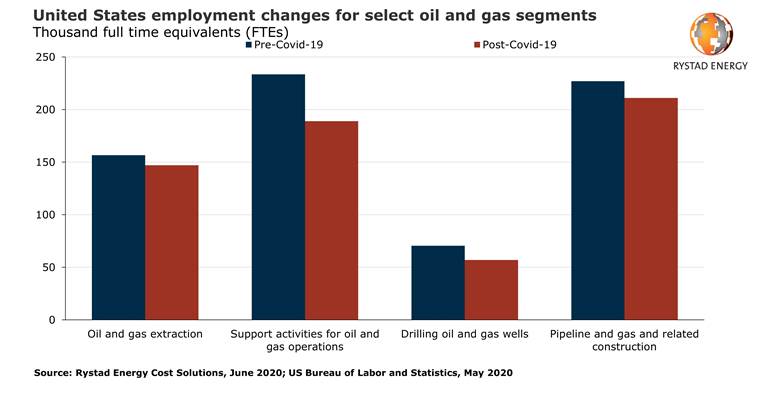More than 100,000 oil and gas jobs already lost in the US, wages seen falling at least 8-10% in 2021
Jun 12, 2020The US oil and gas labor market is amongst the world’s most severely hit by the downturn that the Covid-19 pandemic has brought, a Rystad Energy analysis of the latest data from the US Bureau of Labor Statistics (US BLS) reveals. More than 100,000 oil and gas jobs have already been lost in total, with most of them coming from the support activities market.
The data shows that the four oil and gas segments most affected are support activities for oil and gas operations (44,550 jobs cut from a pre-Covid-19 level of 233,550), pipeline and gas and related construction (16,000 jobs cut from 227,000), drilling of oil and gas wells (13,450 jobs cut from 79,450) and oil and gas extraction (9,600 jobs cut from 156,600).
In addition to the above four segments from the US BLS, Rystad Energy has included more components of the oil and gas industry chain, thus independently estimating the total job cuts to exceed 100,000 to date. The support activities segment in particular reveals a staggering employment slump of 20% compared to February’s pre-Covid-19 levels.
“The job cuts can be attributed mainly to the nosediving oil prices driven by a sharp contraction in domestic oil demand, which has resulted in an unprecedented demand-supply imbalance. In response to the weakened demand, operators and service providers alike have been frantically cutting jobs,“ says Rystad Energy’s Vice President Energy Service Research Matthew Fitzsimmons.

Heavy construction labor demand in the US increased by 3.4% in May, but the oil and gas industry did not contribute to this increase. Since the outbreak of the pandemic in the US in early February, oil and gas construction jobs have decreased by more than 10%. We believe this sector within the oil and gas industry will take a more cautious approach to new construction activity, waiting for the safety risks associated with Covid-19 to recede.
While onshore construction workers can social distance and execute their tasks on duty, issues arise during tool-box talks, mid-morning, lunch, and mid-afternoon breaks. Spreading out the times for breaks and installing additional breakout trailers to minimize the risk from these situations can result in increased indirect costs.
In addition to battling the safety risks with ongoing work, various large operators are now delaying or pulling out of new facility construction. In Louisiana alone, more than 40% of liquefied natural gas (LNG) investments scheduled for this year have been postponed or canceled.
A revival in construction labor demand may take some time as delays mean weather windows for construction will be missed. In addition, the weak financial stability of service companies may leave them unable to ramp up hiring fast when conditions improve.
Job cuts aside, the ongoing downturn will also manifest itself in the form of deep pay cuts. According to our estimates, the wages for various trades in the oil and gas industry are likely to witness a decline of at least 8% to 10% heading into 2021.
The decline in wages and steep job cuts may see workers migrate to other industries with overlapping skill requirements, while some senior workers may retire altogether, as we saw in the previous downturn. Combined with social distancing measures, severe restrictions on international travel and stringent immigration audits, this will adversely impact the hiring of labor once prices and demand stabilize.
Some parts of the US have been affected more than others. Texas has lost more than 45,000 jobs in its upstream sector since February 2020. Similarly, Louisiana will likely see a decline of nearly 25% in its total oil and gas workforce, according to the Louisiana Oil and Gas Association.
“Overall, the impact of the job cuts would be greater for the oilfield services (OFS) sector than for exploration and production companies. OFS companies are likely to see more than 20% of its shale, onshore and offshore workforce combined cut by the downturn. While other industries have started to see labor demand embark on a road to recovery, oil and gas workers will have to wait longer for demand to increase,“ Fitzsimmons concludes.
Similar Stories

2024 Supply Chain Risk Trends Analysis
View Article
Global foreign investments: Diverging trends amid global challenges
View Article
EIA forecasts lower oil price in 2025 amid significant market uncertainties
View Article
Cathay Pacific releases traffic figures for December 2024
View Article
Envana secures grant for $5.2M DOE Methane Mitigation Technology Project
View ArticleFTR Reports U.S. trailer net orders in December at 25,334 units, the most since October 2023
Total trailer production declined 10% m/m in December to 11,827 units, a relatively typical seasonal drop. However, production was down 40% y/y – 43% below the five-year December average –…
View ArticleGet the most up-to-date trending news!
SubscribeIndustry updates and weekly newsletter direct to your inbox!





